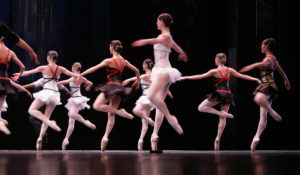Laban’s well-known basic actions combine the movement factors of Space, Weight, and Time. However, the whole mood of an action changes when Flow replaces one of these motion factors. Then the functional action is transformed into a visionary, passionate, or spell-binding mood.
Laban admits that “even when man sets about a working job and his bodily actions have to fulfill practical functions they are distinguished by personal expression.”

However, when flow takes the place of another motion factor, “the expression is more intense.” According to Laban, this is because “These configurations build up individual units in which the single constituent part submerges entirely.” Thus the whole gains a new meaning and importance. In other words, the Vision, Passion, and Spell drives are distinctive moods in which the whole is greater than the sum of its parts, just as green, while being composed of blue and yellow, is a distinctive color all its own. This is where Laban’s effort theory, composed of only four motion factors and eight contrasting effort qualities, blossoms into a multi-colored landscape encompassing both function and expression.
In the forthcoming workshop, “Expanding the Dynamosphere,” we will start with the basic actions and organic sequences of these actions. Then we explore the transformation drives – Vision, Passion, and Spell. Find out what happens to the chemistry of effort when we just add flow!

 correspondence course, Rebecca Nordstrom created a sequence of basic actions and imagined this movement sequence as a scenario involving the
correspondence course, Rebecca Nordstrom created a sequence of basic actions and imagined this movement sequence as a scenario involving the 

 In late April we celebrate National Dance Week. This year’s festivities come with scientific evidence that
In late April we celebrate National Dance Week. This year’s festivities come with scientific evidence that  “You must not think of dance as steps,” Rudolf Laban once told a group of student actors. “Dance is meaningful movement. You can dance with your eyebrows. When I have taught you, you will be able to dance with any part of your body.’’
“You must not think of dance as steps,” Rudolf Laban once told a group of student actors. “Dance is meaningful movement. You can dance with your eyebrows. When I have taught you, you will be able to dance with any part of your body.’’ “Effort is visible in the action movement of a worker, or a dancer, and it is audible in song or speech,” Laban observes in
“Effort is visible in the action movement of a worker, or a dancer, and it is audible in song or speech,” Laban observes in  In discussing the actor who is an artist, Laban writes “this kind of performer concentrates on the actuation of the inner springs of conduct preceding his movements, and pays little attention at first to the skill needed for presentation.” In other words, this actor focuses on the inner intention to move.
In discussing the actor who is an artist, Laban writes “this kind of performer concentrates on the actuation of the inner springs of conduct preceding his movements, and pays little attention at first to the skill needed for presentation.” In other words, this actor focuses on the inner intention to move. I launched the new MoveScape Center correspondence course, Mastering Rudolf Laban’s
I launched the new MoveScape Center correspondence course, Mastering Rudolf Laban’s  Lamb affirmed that “effort goes with shape organically.” Yet careful study of an individual’s movement pattern will reveal an emphasis on effort more than shape, or vice versa. Lamb came to feel that this difference was fundamental and significant.
Lamb affirmed that “effort goes with shape organically.” Yet careful study of an individual’s movement pattern will reveal an emphasis on effort more than shape, or vice versa. Lamb came to feel that this difference was fundamental and significant.